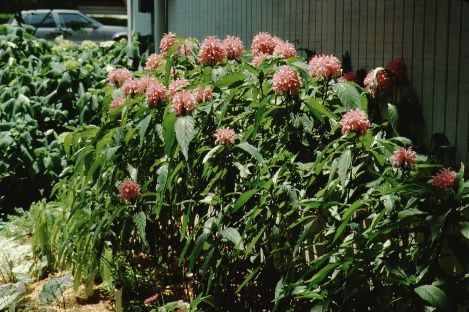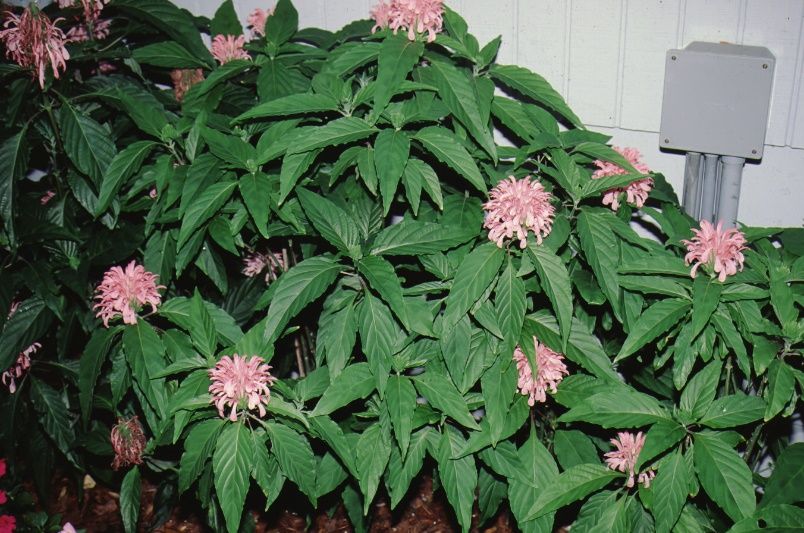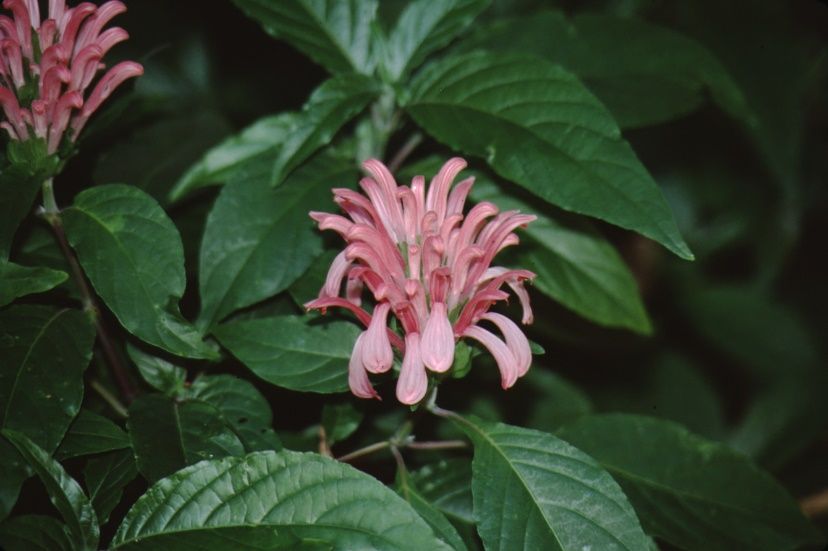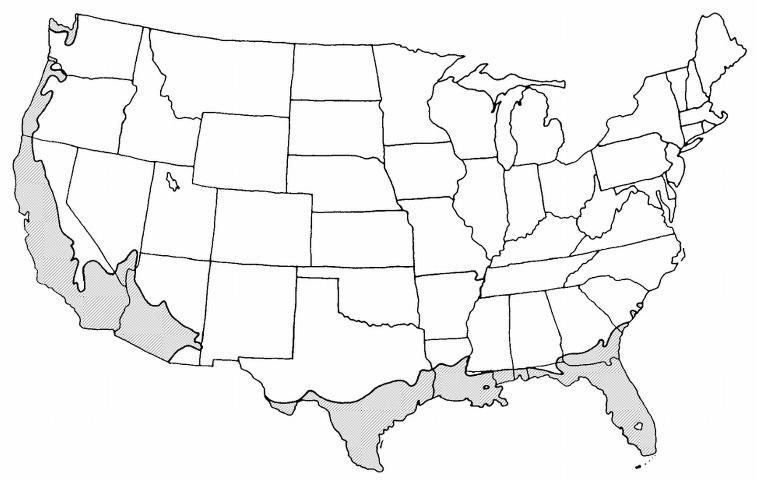Introduction
Jacobinia is an upright, evergreen shrub, 3 to 7 feet tall and wide, with large, 6 inch long, dark green leaves and upwardly facing plumes of tubular, slightly fragrant flower clusters in rose-purple, red, yellow, orange, apricot, or white (depending on the selection), which appear from early summer until fall. The plant cycles through 2 to 4 major flowering periods during the year, with few flowers in between. Many stems appear from the center of the plant and rise straight up for several feet before branching. The rapid growth and evergreen nature make jacobinia ideal for use as a foundation or mass planting. It may be used in various containers, or it may even be trained into an attractive espalier. Use it in front of a green shrubbery border to create a color accent throughout the warm months.

Credit: Edward F. Gilman, UF/IFAS

Credit: Edward F. Gilman, UF/IFAS

Credit: Edward F. Gilman, UF/IFAS
General Information
Scientific name: Justicia carnea
Pronunciation: juss-TISH-ee-uh KAR-nee-uh
Common name(s): jacobinia, flamingo plant, Brazilian-plume
Family: Acanthaceae
Plant type: perennial; herbaceous
USDA hardiness zones: 8B through 11 (Figure 4)
Planting month for zone 8: year-round
Planting month for zone 9: year-round
Planting month for zone 10 and 11: year-round
Origin: not native to North America
Invasive potential: not known to be invasive
Uses: border; mass planting; container or above-ground planter; cut flowers
Availability: somewhat available, may have to go out of the region to find the plant

Credit:
Description
Height: 3 to 6 feet
Spread: 2 to 3 feet
Plant habit: upright; spreading
Plant density: open
Growth rate: slow
Texture: coarse
Foliage
Leaf arrangement: opposite/subopposite
Leaf type: simple
Leaf margin: undulate
Leaf shape: elliptic (oval)
Leaf venation: pinnate
Leaf type and persistence: deciduous
Leaf blade length: 8 to 12 inches
Leaf color: green
Fall color: no fall color change
Fall characteristic: not showy
Flower
Flower color: white; pink; apricot; yellow; lavender
Flower characteristic: flowers periodically throughout the year
Fruit
Fruit shape: pod or pod-like
Fruit length: less than 0.5 inch
Fruit cover: dry or hard
Fruit color: brown
Fruit characteristic: inconspicuous and not showy
Trunk and Branches
Trunk/bark/branches: not particularly showy; typically, multi-trunked or clumping stems
Current year stem/twig color: green
Current year stem/twig thickness: very thick
Culture
Light requirement: plant grows in the shade
Soil tolerances: acidic; slightly alkaline; sand; loam; clay
Drought tolerance: unknown
Soil salt tolerances: poor
Plant spacing: 24 to 36 inches
Other
Roots: usually not a problem
Winter interest: no special winter interest
Outstanding plant: plant has outstanding ornamental features and could be planted more
Pest resistance: long-term health usually not affected by pests
Use and Management
Rain and irrigation weigh the foliage down and cause the branches to spread out, sometimes touching the ground. This limits height growth and opens up the plant to allow light to enter the interior, stimulating growth from the lower stem and inner branches. It has a place in almost every garden in USDA hardiness zones 8b through 11.
Jacobinia should be grown on rich, well-drained soil that receives ample moisture in a location shaded from full-day sun. Although tender to frost, plants will grow back quickly in springtime in USDA hardiness zones 8 and 9. The only necessary pruning during the growing season should be limited to removal of dead flower heads or occasional pinching to stimulate branching. Since flowers form on new growth, prune early in the spring so flower display is not reduced. This increases the number of branches and flowers and creates an attractive, full plant. Older plants benefit from rejuvenation type pruning where most of the taller stems are cut back to a node close to the ground. If this is performed each year, plants should last for many years.
Propagation is by cuttings.
Pest and Diseases
Nematodes and spider mites. Caterpillars occasionally chew portions of the foliage, but these will not kill the plant.
No pests or diseases are of major concern.